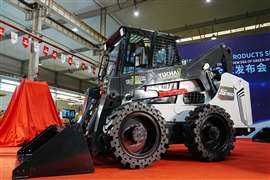Exactly 50
19 March 2008

The worldwide crane and rigging industry lost a longtime leader and friend when Howard I. Shapiro died on 31 May at the age of 75. His career spanned exactly 50 years from his very first day on the job in his father's basement office until he died peacefully at home after a short illness.
“One could say that this sort of thing - having a life that operates like a clock - is something to expect from an engineer, but this remarkable coincidence is nothing more than a coincidence,” says his son Lawrence Shapiro. “Though he navigated through numbers, graphs and equations with ease, his world was not constructed of neat columns and packaged answers. He was a worldly man and a synthesizer of ideas.”
The engineering firm Howard built in the US with his father Charles and his brother Elliott eventually outgrew the family home in Brooklyn, New York. Howard and Elliott Shapiro moved their engineering consulting business to progressively larger quarters, first in Brooklyn then Long Island.
Early in his career, Howard supplemented his civil engineering practice by occasionally serving as a general contractor and a concrete contractor. When a friend needed help figuring out how to move heavy boilers and generators into buildings, Howard learned the engineering of cranes and derricks.
His curiosity led him far beyond the basics of those projects. He gained such an understanding of cranes and derricks that he eventually became a consultant to the manufacturers of the equipment. But the mainstay of the practice was - and remains to this day - crane and rigging work among the high-rises of Manhattan.
Soon he found himself extensively involved with committees that drafted and revised standards both for technical performance and safety of cranes, hoisting machines and related equipment. Beginning in 1972, he served on the Society of Automotive Engineers (SAE) Subcommittee 31, Cranes and Excavators.
His international involvement began in 1973, when he started serving on the International Organization for Standardization (ISO) Technical Committee 96, Cranes and Lifting Appliances, representing the American National Standards Institute (ANSI) for about 30 series of meetings and serving in various capacities in the US delegation. He was a member of Subcommittees SC1 and SC10, Design; SC6, Mobile Cranes;
SC7, Tower Cranes; and SC8, Jib Cranes; and the U.S. Technical Advisory Group.
From 1977 he served on American Society of Mechanical Engineers (ASME) Committee B30, Safety Standards for Cableways, Cranes, Derricks, Hoists, Hooks, Jacks, and Slings. He served as chairman of the B30.3 subcommittee, Construction Tower Cranes, and the B30.4 subcommittee, Portal, Tower, and Pedestal Cranes.
In the late 1970s, the business went into decline as the New York City economy tanked. Howard took advantage of the slow period to write one of the industry's most indispensable reference volumes, Cranes and Derricks, first published by McGraw-Hill Book Company in 1980. He also took advantage of that time to streamline the business.
“When he realized that the firm was not economically as efficient as it could be, he conceived the financial and operating structure that made our firm as strong as it is today,” says his son Jay Shapiro.
Soon after, sons Lawrence and Jay joined him as both his business partners and co-authors. He also recruited his daughter Gail to run the business end of the office. In addition, he turned to his fourth child, Daniel, a respected account and tax consultancy attorney, for financial and tax advice.
Eventually he turned the business over to Lawrence and Jay. Nothing gave him more pride than working with his engineering sons as the firm grew to nearly 30 employees, according to Dorothy Shapiro, his wife of 53 years. “When people would ask Howard where he worked, he would proudly say, ‘I work for my sons,’” she says.
Howard Shapiro also was a patriotic American. He was a 1st lieutenant during the Korean War. “He was never without his little flag on his lapel,” remembers his wife. “Every national holiday, the American flag flew in front of the Shapiro home.”
His patriotism became even more evident when he travelled overseas. Norman Hargreaves, a colleague with Terex, who met Howard Shapiro in the early 1980s, remembers the brazen red, white and blue sweater he made a point of wearing when visiting communist Russia and other Soviet Bloc countries.
Despite his light-hearted nature, Howard Shapiro was deeply committed to his work on behalf of the crane industry. “He was very, very instrumental in standards writing, and he was very good with structural analysis,” says Hargreaves, who was attending an ISO Technical Committee 96 meeting in China when he learned of Howard Shapiro's death. “His tremendous contribution to TC96 standards was recognized at the meeting, followed by two minutes of silence,” Hargreaves notes.
Hargreaves also points out Howard Shapiro's important role as an accident investigator, a position that often involved court testimony. “He was unflappable as a witness and he got great pleasure in sitting in the witness box, calmly responding to the opposing attorney's attempts to make him nervous and unreliable in his testimony,” says Jay Shapiro.
To help honour Howard Shapiro, several of his fellow SC&RA members plan to establish an SC&R Foundation Scholarship named after him. For further information on the SC&R Foundation's Scholarship programme, call +1 (703) 698 0291.






